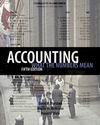 Accounting: What the Numbers Mean, 5/e David H. Marshall,
Millikin University
Wayne W. McManus,
International College of the Cayman Islands
Daniel F. Viele,
Webster University
Cost Analysis for Decision Making
Chapter 16 Outline
Cost Classifications- Classifications for Other Analytical Purposes
- Differential cost.
- Allocated cost.
- Sunk cost.
- Opportunity cost.
|
 |  |  | Short Run Decision Analysis- Relevant Costs
- Irrelevant Costs
- The Special Pricing Decision
- Under conditions of Idle Capacity
- When Operating at Full Capacity
|
 |  |  | Capital Budgeting- Investment Decision Special Considerations
- Time Value of Money.
- Involvement of Board of Directors.
- Cost of Capital
- Capital Budgeting Techniques
- Methods that use present value analysis.
- Net present value.
- Internal rate of return.
- Some analyticalconsiderations
- Estimates.
- Cash flows far into the future.
- Timing of cash flows within the year.
- Investments made over a period of time.
- Income tax effect of cash flows from the project.
- Working capital investment.
- Least cost projects.
- Methods that do not use present value analysis.
- Payback.
- Accounting rate of return.
- The Investment Decision
- Integration of Capital Budget with Operating Budgets
|
| 

 2002 McGraw-Hill Higher Education
2002 McGraw-Hill Higher Education